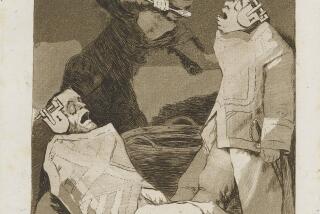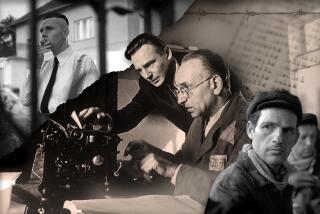Human Faces for Our Favorite Evildoers
Almost everyone would agree that Hitler, Stalin and Mao were among the greatest monsters in human history, and that Osama bin Laden is the brutal Islamo-fascist enemy of everything we hold dear. All are such peerless villains that they have become brand names of demonology, cited glibly by politicians and serving as raw material for that most futile of dinner-party parlor games: “Who killed more people?
Yet strangely, many people are averse to learning more about these men. Although the challenge for historians is, obviously, to explain their rise, fanaticism and maintenance of power, many readers and critics continue to insist that these diabolical revolutionaries must be portrayed only as inhuman devils, as caricatures, as monsters -- not as wicked-but- practical politicians or as degenerate-but-subtly-rounded human beings.
Every time a new book or film on Hitler appears -- such as the recent bio-pic showing his rise -- there is an uproar that he is being inappropriately “humanized.” A recent BBC documentary interviewed Bin Laden’s school pals, who remembered his charm, elegance and intelligence -- shocking many viewers who apparently didn’t want to hear such things.
Until now, Stalin has been the most shadowy of these dark legends. But newly opened archives suddenly allow us to paint a more human Stalin than ever before. They expose depravity, perversion, luxury and sadism in a self-righteous world of murder by quota and personal vendetta -- all symptoms of a rotten creed imposed by violence.
But they also reveal Stalin’s human aspects -- his womanizing (never without a mistress even as a penniless exile), intellectualism (he loved Goethe, Balzac, Hugo, “The Last of the Mohicans”), his warmth toward his subordinates (he chose Beria’s house personally and tucked his children into bed), his fine singing voice, his regrets, and his love for his daughter, whose homework he checked nightly.
In its review of my new biography of Stalin, the New Yorker sensibly sounds a warning about our fascination with the intimate world of monsters from Bin Laden or Hitler to the Red Tsar: “Any biography of a tyrant runs the risk of humanizing its subject to the point of appearing to mitigate his crimes.”
In other words, should we know, or do we care, whether Bin Laden is a fine father, how Stalin wrote love letters or how Mao danced?
We do, and here’s why: For years, popular history has coasted along on the myth that the Nazi, Soviet and Maoist regimes were murder sprees organized by a single madman. But historians of tyranny have two missions: to inform readers how and why these people ruled and killed, and to deliver warnings from the past. If we simply present Hitler and Bin Laden as one-dimensional satanic psychopaths, there is no warning; we learn nothing about them, their cultures, why those nightmares happened.
The intimate approach to Stalin is also key to creating a new paradigm of that regime. It turns out the personal approach is, in fact, the correct way to understand Leninism-Stalinism. The new archives show that even though the leadership was made up of fanatical Marxists and enthusiastic killers, power was personal, informal and based on patronage.
The old picture of Stalin is absurd. If he had been merely a charmless psychopath, he would never have risen to power, let alone maintained it. He was grotesque all right, but also a complex and subtle bundle of contradictions. The devil is in the details.
Of course, readers and critics may find it hard to accept that Papa Stalin was a sweet father to Svetlana while supervising the Great Terror. But it is a fact. Most of those murderous Bolsheviks had normal family lives -- especially Molotov but even the sadist-rapist-sex-addict Beria. How can this be?
They were simply fanatical believers in a creed that included mass murder to make a better world. And politics was their superlative interest. Everything -- family and friendships -- was subordinated to and poisoned by politics.
It is patronizing to censor such personal details of these monsters on the grounds that readers are not qualified to decide themselves; then history becomes cliche, or worse, propaganda. Most readers can make such judgments for themselves. Yes, such works must be meticulous in scholarship: A book that concentrated on Hitler’s sketching or Stalin’s poetry while ignoring his brutality would be iniquitous. But we owe the reader a complete picture.
Furthermore, the closer one comes to Stalin -- man, father, lover -- the more disgusting he becomes. Far from humanizing a monster, this kind of intimate portrait can, as the New Yorker noted, throw coldhearted brutality into sharper relief.
Character is not just about readable fascination. Character matters because responsibility matters: Germany redeemed itself because it faced the truth of Hitler’s charm, popularity -- and criminality. Stalinism, on the other hand, continues to overshadow Russia: no truth, no redemption.
Plutarch, master of personal history, explained in his “Life of Nicias” that “detail” is never “unnecessary” because it contains fundamental truths: “passing on the essence that promotes the appreciation of character and temperament.” Yes, the inconvenient facts about the intimate humanity of a Stalin or Bin Laden are indeed shocking. And they are meant to be.
More to Read
Sign up for our Book Club newsletter
Get the latest news, events and more from the Los Angeles Times Book Club, and help us get L.A. reading and talking.
You may occasionally receive promotional content from the Los Angeles Times.







